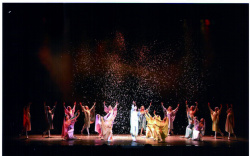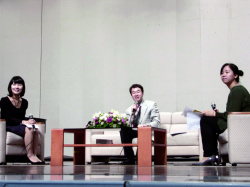Tracing after hidden deeds and meanings of Ewha chapel

History of the Ewha chapel
During the semester, anyone can see a typical but enjoyable scene at Ewha at 10 or 11:30 a.m. Students furiously racing up the stairs to the Auditorium, even in their high heels or skirts, to ensure they are not late for Ewha chapel. Many Ewha students consider going to chapel tiresome and even question the need of it. However, Ewha chapel is more meaningful than it might seem at first.
The relationship between chapel and Ewha has been inseparable from its beginning. The first official record of chapel appears in 1896. After morning classes, students participated in chapels, which lasted 15 minutes each day. Participating in short chapels was a part of the students’ daily lives.
However, holding chapel was interrupted or temporarily forbidden during the Japanese colonial rule of Korea. During the Korean War, chapel was held in a shantytown where Ewha students gathered to pursue their studying.
After the treaty of truce between South and North Korea, Ewha reopened and the number of students increased dramatically. Because of the large student body, students could not participate in one chapel as a whole, but rather did so in small groups. This problem was solved when the Welch-Ryang Auditorium, where chapel currently takes place, was built in 1956.
One of the unique characteristics of the Ewha chapel is that it involves a lot of cultural aspects.
“Ewha chapels last 30 minutes. It is quite short. In that, we aim for moving students’ minds by telling them how important they are and their friends are,” said the university chaplain Sohn Woon-san. “Also, we hope they could be motivated to become future female leaders with humanitarianism.”
Since the number of non-Christian students is big, chapels focusing on Christian education have changed into chapels with cultural characteristics like performances that are easily approachable to non-Christians.
“We believe chapel should focus on encouraging and introducing the Christian spirit of caring for the weak, rather than missionary purpose,” Sohn said. “We are trying to make chapel more non-Christian friendly by introducing and sharing the values of Ewha, which is to become a woman leader who cares social minorities.”
Chapel, friendly folk or a headache of school life
Ewha chapel can be considered a symbol of Ewha since all students attend from their freshman to senior year. Sometimes chapel is a controversial issue due to its compulsiveness. For students who fail chapel because of excessive absences, chapel becomes an accumulated spiritual debt. They have to shoulder the burden of taking two chapels in one semester.
However, apart from ordinary students dozing off during sermons, there are some students who appreciate the chance to enrich their experience, and occasionally even careers, thanks to Ewha chapel.
Students on stage and in the spotlight at chapel

Some students from the College of Music perform in the morning chapel during the semester. Chapel, being a large-scale worship service attended by 2,000 students, professors and guests outside of Ewha, is a perfect chance to practice stage performances.
“Being on the stage allow me to be a more experienced musician,” You Kyung-min (Orchestral Instruments, 3) said.
But the chance to play during chapel is slim. Students with advanced skills or graduate school students usually perform.
Music melodies are not the only attraction of Ewha’s chapel. Dance chapel, another marked feature of Ewha’s chapel, performed by students from the Department of Dance.
“For the 30 minute dance chapel, students practiced for months,” said Lee Eun-mi (Dance, 4) who participated in chapel stage for two years. “Students and professor prayed and read Bible story together to fully understand the dance piece. It helped me in learning practical skills.”
As an emcee of the Ewha chapel

Poet Jeong Ho-seung and account strategist of Google Korea Kim Tae-won have been invited to Ewha chapel to share their stories as if they were on a TV talk show—a show hosted by Ewha students.
“For me, talking with celebrity guests in chapel was more nerve-racking than an ordinary camera tests,” said Kim So-yeon (’10, Business), who is currently pursuing a career as a broadcasting announcer. “It was sort of a simulation of live broadcasting. By watching their expressions, I got minute-by-minute feedback from audiences.”
Due to the one-of-a-kind experience achieved by being the emcee of a conversation chapel, the Chaplain’s Office’s emcee audition raises great competition.
“Although I don’t have any religion, chapel is surely helpful for some students to be progressive amateurs in their fields,” Jun Hae-lim (Sociology, 4) said. “It is chance to go further and to the broader stage.”
Offering made in chapel Branching out around the world

The Ewha chapel has an effect on not just Ewha students, but others as well; Money contributed by students and faculty members during chapel is used for children and women in difficult situations through many relief organizations.
Ewha students make an offering of money to chapel once each semester. They make an offering during Easter week of the first semester, and again during Thanksgiving week of the second semester.
The Ewha chapel is now participating in four long-term supporting projects: the Ewha well project, the project of support ing 10 children in the Third World countries, migrant women, multicultural children and children in North Korea.
Three Ewha wells were built in Zambia, from 2007 to 2009, and the fourth well is now being built in Kome Island, Tanzania which will be completed in October. The Ewha chapel has a plan to build 10 wells in total through the Ewha well project.
For the project of supporting the Third World countries’ children, the Ewha chapel plans to give financial aid to 10 children for 10 years. The Chaplain’s Office regularly receives and writes letters for the children.
“It is our dream to see 10 children attending Ewha,” Sohn said.
In 2006, the Ewha chapel supported Cambodian women for eyesight recovery operations. In 2007, the funds were donated to Mongolian students studying at school for foreign youths in Jangan-dong.
Ewha provided help to the poorly-fed children in North Korea by spending offerings on building a medical wing and a soybean milk factory. Furthermore, the chapel remitted blankets and bread to North Korea.
Keywords of the Ewha chapel’s supportings: Sharing and Serving
In addition to above four projects, there are other supports from the Ewha chapel: Providing a water pump, sending disaster relief funds for Myanmar, and remitting payment for 50 sheep in Uzbekistan are just a few exemples. The Ewha chapel has also supported missions in Cambodia and Kenya, built a school in East Timor, and gave financial support for food in Uganda.
During the remainder of 2010, four huge projects are planed to go off as scheduled, and the Ewha chapel is willing to support any organization that is in need of help.
“Among several ecumenical virtues, the Ewha chapel aims for ‘sharing and serving.’ I hope that all Ewha students come to know that humanity, including themselves and other people around them, is precious,” Sohn said. “Moreover, I want them to have warm hearts and interests toward the world.”

